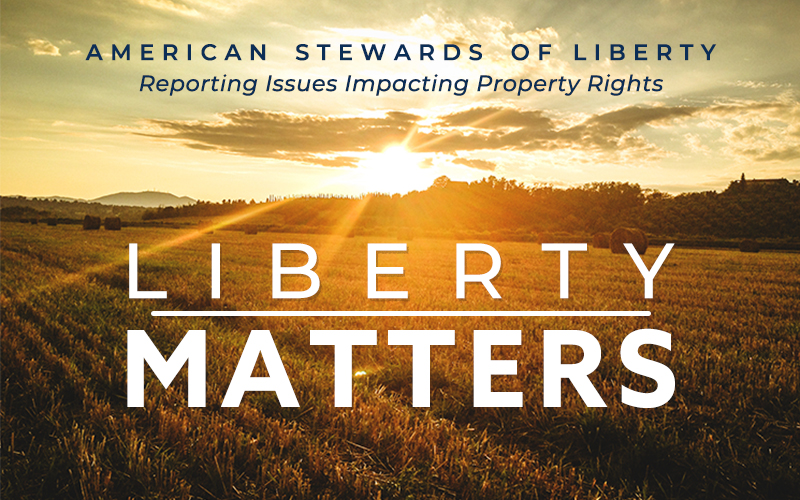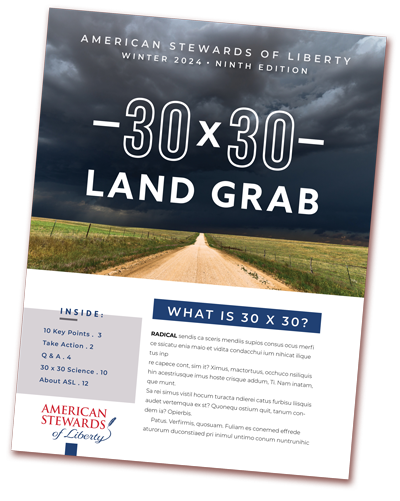In this issue…
Opposition Growing Against Biden’s 30 x 30 Land Grab
Bypassing Committee, Massive Wilderness Bill Passes House
USFS Extends Comment Period for Manual Update: Coordination Not Included
Reforesting Pasture Lands
Smoked Prime-Rib
Opposition Growing Against Biden’s 30 x 30 Land Grab
As word spreads of the Biden Administration’s push to “permanently protect” 30 percent of our nation’s land and oceans in their natural state, opposition is growing. Nebraska Governor Pete Ricketts issued a strong warning to the Biden Administration on February 22nd:
“In particular, I want to draw the attention of Nebraskans to the executive order’s goal of restricting ‘at least 30 percent of our lands and waters by 2030.’ Federal interventions that purport to aim at conservation or that regulate land and natural resource uses are only likely to hurt agriculture and to hinder growth in our economy. Nebraska will stand up against federal government overreach to protect our family farms and our way of life. Just as we defeated President Obama’s Waters of the U.S. regulation, we will work together to stop new federal overreach.” (Gov. Ricketts Warns Against Federal Overreach on Energy, Climate, & Conservation Issues)
Governor Ricketts is the first of his colleagues to shine the national spotlight on the impact the 30 x 30 provision will have on States as a result of the climate crisis Executive Order (14008).
Additionally, Representative Lauren Boebert (R-CO) introduced an amendment to the Wilderness bill passed by the House last week (H.R. 803) that nullified section 216 of the climate crisis EO. While the amendment was not accepted, it alerted other members to the dangerous agenda. House Resource Committee Ranking Member, Bruce Westerman (R-AR), noted that the massive wilderness bill was being pushed by the same extremists advocating for the 30 x 30 program.
Several more Counties are following the lead of Garfield County, Colorado, which passed the first local government resolution opposing 30 x 30, by passing similar policies. The resolutions are key to helping Congressional leaders fight against the agenda in Washington D.C.
Individuals across the nation can join the fight. We prepared the “Guide to Fight 30 x 30,” to make it easy to educate neighbors and elected leaders. It includes fact sheets, resources, background material and model resolutions local governments can pass to oppose the program — and it is free.
Bypassing Committee, Massive Wilderness Bill Passes House
The normal process for House bills begins in the committee with jurisdiction over the issue, and for H.R. 803, the massive wilderness bill that just passed the House, that would be the House Natural Resources Committee. The bill sponsor instead went straight to the Rules Committee where Democrats make up 9 of the 13 members. With a Democratic majority, the bill passed out the Rules Committee and onto the House for the floor vote in four short days. It was an underhanded ploy by the majority to avoid a transparent discussion as to whether the nation wants to lock up more of America’s land.
Here is what is in the bill:
* Creates 1.5 Million Acres of New Wilderness
* Withdraws 1.2 Million Acres from Mineral Production
* Designates 1,200 Miles of New Wild and Scenic Rivers
* Expands 110,000 acres of national monument land
* Adds 400,000 acres of recreation, conservation, and special management areas
Many of the lands under consideration in this bill do not meet the basic characteristics to be considered wilderness. The bill also raises critical national security concerns. The areas designated for permanent mineral withdrawal contain rare earth minerals our nation needs for high tech products, batteries, and other key products, now being imported from Europe and China.
The Bill’s sponsor, Rep. DeGette (D-Co), from Denver, added the portion of the bill that converts over half a million acres of Rep. Boebert’s district into Wilderness without taking an acre out of her own area. And in the spirt of Speaker Pelosi, some of the Wilderness boundary descriptions in the bill are so fuzzy, Members didn’t know exactly what lands they were taking before voting for its passage.
The bill passed the House with a vote of 227-200. Eight Republicans voted for the bill. They are: Fitzpatrick (R-PA), Garcia (R-CA), Mace (R-SC), Meijer (R-MI), Simpson (R-ID), Smith (R-NJ), Upton (R-MI), Van Drew (R-NJ). One Democrat broke ranks and opposed the bill: Gonzales, (D-TX)
The bill now moves to the Senate where proponents are expecting a tougher fight. Your Senators need to know you oppose this bill.
USFS Extends Comment Period for Manual Update: Coordination Not Included
The U.S. Forest Service is revising their rangeland management directives, which serve as the primary guide to employees as how to carry out the rangeland program. Unlike the Forest Service planning rules, which can be challenged under the Administrative Procedures Act, these directives are internal guidance to employees on how to carry out the program.
The agency is taking comments on the rangeland manual update through April 16th.
The directives have not been revised for over 30 years and one purpose for the revision is to eliminate outdated policies and bring the manuals into conformance with current law. The updates are for Manual (FSM) 2200, Forest Service Handbook (FSH) 2209.13 and FSH 2209.16, with the majority of changes being made to Forest Service Handbook 2209.13. They include updates on conservation easements, the national grasslands, tribal treaty grazing rights and succession planning.
Absent from the update are directions on how forest service employees are to facilitate coordination of local government policies. Last year, the forest service and the National Association of Counties released the “County Government and the USDA Forest Service: A Guidebook for Working Together,” which calls on the agency to coordinate with local governments. It would be appropriate for the forest service to formally incorporate these acknowledgments into directives to agency employees.
Although the directives are internal and not subject to litigation, they do guide forest service employees in their day-to-day management activities. For local governments who have forest service managed lands in their area, submitting comments as to how these directives could better facilitate the coordination of local government policies, would be prudent.
The new Policy Coordination Guide for Local Governments, released by American Stewards at the end of last year, includes a model coordination agreement between the agency and local governments and provides specific process steps for implementation. This could be submitted to the agency as a county, city, special district’s comments to the manual update.
Reforesting Pasture Lands
The Nature Conservancy recently unveiled a new tool, dubbed the Reforestation Hub, that ranks the areas most suitable in the United States for reforestation as a means to fight the “climate crisis.” The state-by-state analysis includes a map that shows the reforestation ranking for each county, which has been created using data including land uses of private and federal lands.
The purpose of the tool is to help people see the areas in their communities that provide the most return for the climate, if they were to be converted into forests.
The lands identified as having the best reforestation opportunities are private lands in the Eastern half of the United States, while the vast federal holdings in the West hold a lower ranking. The study finds there are 132.89 million acres of “reforestation opportunity,” and 114.64 million of these acres are private land. 65.51 million acres, the largest use group identified, are pasture land.
The problem for the proponents of this “reforestation” agenda is how to convince private landowners to convert lands from current uses, such as raising livestock, into permanent forests … by 2030. They concluded the following:
“We found that restoring forests to pasture lands represented the single largest opportunity to mitigate climate change. This opportunity class contains over half of the area of opportunity (56%) and two-thirds (66%) of the mitigation potential. The area of opportunity we identified represents 13% of total range and pasture within the contiguous US. Returning these lands to forest would likely require a shift toward plant-based diets in line with current diet recommendations and recommendations for climate change mitigation.” (Lower cost and more feasible options to restore forest cover in the contiguous United States for climate mitigation, One Earth)
E&E News reported the solution more succinctly:
“On the other hand, the groups said, some pasture could be converted to forest if Americans cut down on meat consumption. That would reduce the demand for livestock grazing.” (Report spotlights prime tracts for U.S. reforestation, E&E News (subscription))
Smoked Prime-Rib
Our favorite way to eat prime rib is to first sear the outside on high, then smoke it low on the grill, about 15 minutes per pound for medium-rare. A short rest and then eat your fill. The next day, slice off a rib from the leftovers, salt and pepper each side and sear it on high in a cast iron frying pan. We like mesquite wood for the smoke.





